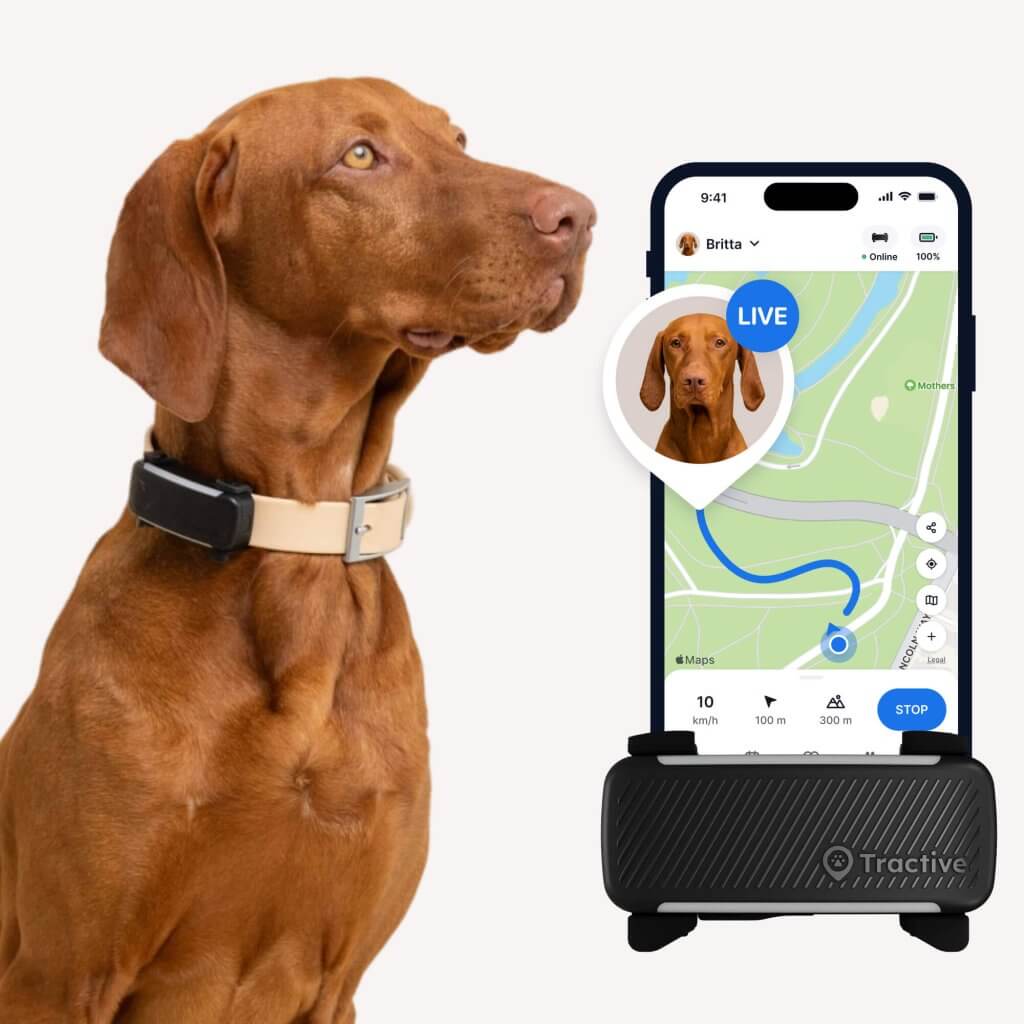Service Dogs & Emotional Support Dogs: What’s The Difference?
What's the difference between service dogs & emotional support dogs? Turns out, they're both two different roles depending on their tasks and training. Here's a deep dive exploring what sets them apart.

There’s a reason we consider dogs our best friends. The roles they play in our lives go far beyond just playing fetch or giving us the good old puppy eyes. And among these roles are two that are often used interchangeably. Aka, service dogs and emotional support dogs. What’s the difference between them? And does it even matter?

Always know your buddy is healthy & safe
Read more- Service dogs: Trained to support people with disabilities
- How are service dogs trained?
- What kind of tests do service dogs go through?
- How service dogs are protected under US law
- Do service dogs need to be certified?
- Should you pet a service dog if you see one in public?
- Emotional support dogs: Providing support & companionship
- Are emotional support dogs the same as service dogs?
- What do emotional support dogs do?
- Are emotional support dogs legally protected ?
- How can a dog be registered as an emotional support animal (ESA)?
- Wrapping up: 4 key differences between service dogs & emotional support dogs
Service dogs: Trained to support people with disabilities
Service dogs are highly-trained dogs who perform certain tasks for people with disabilities. These tasks are directly related to the person’s disability. With the help of a service dog, this helps them be more independent and experience an improved quality of life. According to the Americans With Disabilities Act (ADA), disabilities can be physical, mental, psychiatric, sensory, or intellectual in nature.1 Importantly, they might limit a person from one or more major life activities, or activities of daily living (ADLs).
So you might have seen a service dog:
- Guiding a visually-impaired person across a street (what’s referred to as a seeing eye dog)
- Helping a person using a wheelchair open a door or a cabinet
- Alerting a hard of hearing dog parent to sounds, like a doorbell or someone approaching (or a hearing or signal dog)
- Preventing a person on the autism spectrum from wandering away (or a sensory signal dog)
Besides these, service dogs might also be trained to detect upcoming health conditions.2 These include seizures, epilepsy, or even psychiatric episodes (like with Post-Traumatic Stress Disorder, or PTSD.) In fact, psychiatric service dogs are specifically trained to detect the onset of these disorders So they might remind their parent to take their medication or intervene if they’re about to endanger themselves.
How are service dogs trained?
Service dogs go through many hours of training and preparation. Sometimes, it might take them up to 1-2 years to be fully trained.3 In fact, under the ADA, service dogs must be able to complete tasks that help a person with a disability.4 Like, for example, fetching a far-away item from a fridge or switching off a light when instructed. You could train your own service dog, send your dog to a specialized training program, or be assigned a service dog by a trainer. But importantly, in the US, people with disabilities have the right to train their service dogs by themselves.5 They’re not obliged to send their dog for training at a professional program to assist with their ADLs. However, experts recommend you be involved at each stage of a service dog’s training.6
What kind of tests do service dogs go through?
Many service dogs go through a public access test.7 This is a test for how a dog might behave in non-pet environments, like restaurants or public transport. In these situations, service dogs must be attuned to their parent at all times and not be easily distracted by the sights, sounds, and smells around them. Besides these, service dogs also undergo basic obedience training, which includes following commands like:
- Sit
- Heel
- Look at me
- Down
- Leave it

Keep track of your dog’s daily adventures
Follow every step with unlimited range Live Tracking. Get alerts if they wander too far. Keep them happy & healthy with Activity & Sleep Monitoring. Get Health Alerts if something seems off.
How service dogs are protected under US law
Under the US Americans with Disabilities Act (ADA), service dogs are considered as such because of their intense training.8 Aka, when they’re individually trained to perform tasks directly related to a person’s disability. As a result, they’re considered a disability accommodation. Because of this, businesses can’t charge extra or refuse entry when a person with a disability comes accompanied with a service dog.
So because of these legal protections, service dogs have access to places where pets might otherwise be restricted.9 For example, you can bring your service dog into a restaurant, library, public transport, and even some airplanes. However, it’s important that they’re well-trained and on their best behavior in non-pet public places.
Do service dogs need to be certified?
No, under the ADA, it’s not necessary to register a service dog as such.10 However, if they are registered and certified by a reputable national organization, it can help signal that they’re at work supporting their parent with their disability.11 With a service dog ID card or harness, it can help differentiate them from a regular pet. However, these aren’t mandatory.
Should you pet a service dog if you see one in public?
No – it’s best to give service dogs some space if you see one in public. They’re keenly attuned to the needs of their parent, even in distracting or stressful environments. This is why it’s better not to pet or approach a service dog if you see one outdoors. They’re hard at work taking care of their parent and attentively meeting their needs.12
Emotional support dogs: Providing support & companionship
Emotional support dogs provide comfort and companionship to people experiencing mental health difficulties.13 In fact, any animal could be considered an emotional support animal (ESA) – not just dogs. Their role is to provide a loving, non-judgmental, supportive presence when their parent is experiencing mental health difficulties.
Are emotional support dogs the same as service dogs?
No. Emotional support dogs don’t need any formal training to help improve one’s mental health. In fact, they’re considered on the same level as pets. Meaning, emotional support dogs don’t have the same legal status as service dogs. But under US law, a health professional can prescribe an emotional support animal (ESA) to a single person as a part of their therapeutic plan.14
What do emotional support dogs do?
An emotional support dog can offer you comfort and a sense of acceptance and security when you’re experiencing emotional or psychological difficulties. (Like, for example, cuddling close to you when you’re crying.) When they’re near, it can potentially reduce feelings of anxiety, depression, and even some traumas.15 Much like therapy dogs, emotional support dogs can help people feel more relaxed and accepted with their supportive, non-judgmental presence.
But are emotional support dogs the same as therapy dogs? No. Both dogs might do similar work – i.e. providing companionship and comfort. But emotional support dogs primarily support one person experiencing mental health difficulties. Therapy dogs, on the other hand, work with groups of people in care environments like hospitals, facilities, crisis zones, and even schools.
Emotional support dogs are primarily intended to support you through your mental and emotional difficulties. Some mental health professionals might prescribe them as part of a therapeutic treatment plan. But they might not be the best choice for people with physical, developmental, or cognitive disabilities, since they lack the necessary training.
Are emotional support dogs legally protected?
No. Emotional support dogs aren’t protected legally the way service dogs are under the ADA. The ADA even states that animals that simply provide emotional comfort don’t qualify as service animals. Emotional support dogs might be able to accompany a parent to most housing and transportation services, who might make accommodations. They’re also protected under the US Fair Housing Act, which lets them stay with their parents.16 But their access to other public places (like, say, cafes or museums) might be limited.
Importantly, emotional support dogs aren’t the same as psychiatric service dogs.17 The difference lies in their training and tasks these dogs perform. Under the ADA, if the dog is simply offering a comforting presence when their parent is experiencing mental health difficulties, they don’t qualify as a psychiatric service dog.
How can a dog be registered as an emotional support animal (ESA)?
These dogs should be prescribed as part of a mental health treatment plan by a professional.23 The patient in question also needs to be experiencing a disabling mental illness that’s recognized under federal law. Along with this, a team of mental health professionals usually need to determine that the presence of an animal is vital to the treatment of the patient.
Certifying an emotional support dog as an ESA can help qualify people to be accompanied in places where pets might not be allowed (like when renting a flat). For this, you’d need an ESA letter issued by a qualified mental health professional, stating why the presence of an emotional support dog is necessary. Different public services (like airlines) might have different requirements – so make sure to check those in advance.
Wrapping up: 4 key differences between service dogs & emotional support dogs
| Service dogs | Emotional support dogs | |
| Training | Intensive, required | Basic, not required |
| Tasks | Completing tasks for people with disabilities | Providing emotional comfort and companionship to people with mental health difficulties |
| Access | Full public access | Limited public access |
| Legal protection | Fully protected under the Americans With Disabilities Act (ADA) | Not protected under the ADA, but included within the Fair Housing Act |
Now that you’re informed about the difference between the two, you can better understand the legal rights and responsibilities associated with each type of dog. In both cases, it makes sense to get in touch with a healthcare professional and legal experts who can help you make an informed decision.



